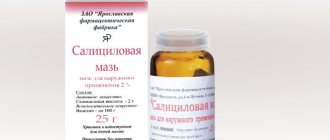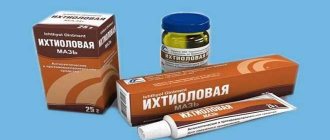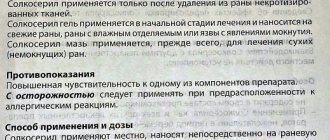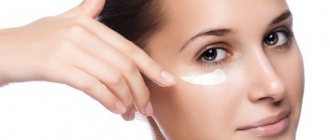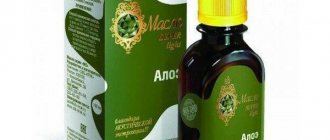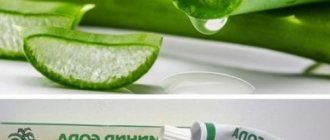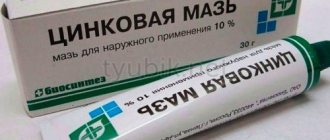The uniqueness of the composition of solcoseryl
The ointment has a uniform, greasy texture; the color can vary from deep white to yellow, with a characteristic odor of broth and petroleum jelly.
The active components of solcoseryl include deproteinized (removal of proteins) hemoderivat from the blood of 3-month-old calves at a concentration of 2.07 mg/g. Auxiliary components are represented by methyl parahydroxybenzoate and propyl parahydroxybenzoate (preservatives), palmitic alcohol (emulsifier), white petrolatum (ointment base), water for injection (dissolution of dry dialysate).
An analogue of the drug is Actovegin ointment. These drugs appeared on the pharmaceutical market almost simultaneously and differ only in the manufacturer and price.
The main active ingredient of solcoseryl is a deproteinized hemoderivat, which is obtained by dialysis and subsequent ultrafiltration. During the production process, high molecular weight proteins are removed (deproteinization). This is a complex compound that includes natural low-molecular substances with a molecular weight of up to 5000 Da.
Such a unique composition cannot be reproduced in laboratory conditions. Basically, these are electrolytes, amino acids, nucleotides, nucleosides. The effectiveness of only some of these substances has been described and proven from a pharmacological point of view. However, in vitro tests have proven the effectiveness of solcoseryl in the treatment of damaged tissues and wound surfaces.
We draw a conclusion
Solcoseryl is not a cosmetic product. This is a drug that has proven itself well as a wound healing and restorative agent.
Its use in cosmetology is rather experimental in nature. Reviews about its use for acne treatment are contradictory - from very useful to completely useless and even harmful. But using Solcoseryl as a remedy against stains and other signs of inflammation can bring tangible benefits.
Pharmacological action of the ointment
The pharmacological properties of the drug have not been fully studied. However, during the studies it was proven that solcoseryl has the following properties:
- in case of oxygen deficiency, its delivery to damaged cells is ensured;
- glucose transfer in metabolic disorders;
- is a catalyst for the formation of intracellular ATP;
- ensures the storage of energy in mitochondria generated during the transformation of nutrients;
- supports cells during nutritional deficiencies by supplying high-energy phosphates;
- prevents or prevents atypical changes with minor cell damage;
- “launches” the process of natural restoration of cells and tissues;
- activates the proliferation (division and formation) of fibroblasts that form the framework of connective fibers, and the formation of collagen filaments in the walls of blood vessels.
The ointment is widely used in cosmetology, gynecology, ophthalmology, and dentistry.
Main indications for use of the product
Ointment with solcoseryl is recommended for:
- minor skin damage in the form of abrasions;
- burns (except chemical) 1-2nd degree, which occur without the formation of exudate;
- frostbite of the 1st-2nd degree in the absence of wound weeping;
- psoriasis;
- to eliminate dry calluses and corns;
- to prevent the formation of scars after laser removal of warts or moles;
- atopic and seborrheic dermatitis;
- “sticking” in the corners of the mouth;
- drying of the nasal mucosa;
- in the treatment of wounds that heal poorly, including trophic ulcers and bedsores, after removal of dead tissue.
As a rule, a gel with solcoseryl is first applied to treat the wound surface with the separation of exudate. After the first signs of wound granulation appear, therapy is continued with the drug in the form of an ointment.
Differences between the ointment form of solcoseryl and the gel form
Pharmacies offer 2 forms of the drug intended for external local use. How do they differ and is it necessary to pay attention to such nuances?
The main differences between the forms are due to the excipients. Thus, solcoseryl gel does not contain fatty bases, which is why it is quickly washed off with warm water and removed from the surface of the skin. Due to this, it is the gel form that stimulates the formation of granulation tissue and the elimination of wound exudate.
When the wound dries out and signs of granulation appear, it would be more appropriate to use ointment. The fatty base of the drug forms a protective film on the surface of the wound, so the healing process is noticeably faster. In addition, solcoseryl ointment softens the surface of the wound, thereby avoiding the appearance of scars and other skin defects.
Can Solcoseryl get rid of acne?
When treating skin problems with Solcoseryl - burns, abrasions, scratches - ointment and gel are usually used.
Differences between ointment and gel
The active substance and its concentration in both forms of the drug are identical. They differ only in the auxiliary components that give them the consistency of an ointment and a gel.
Solcoseryl gel is recommended for use on open wounds. It creates a thin film that accelerates healing. Once the wound is no longer “wet”, they switch to ointment.
Solcoseryl and acne
There are no positive reviews indicating that acne and inflammation actually disappear after using the drug.
Reviews of those who have used Solcoseryl for this purpose are replete with information that the gel has no effect on inflamed skin at all. If you apply the ointment not precisely to the affected area, but to large areas, it provokes clogging of the pores and new inflammations.
How to use the ointment
Instructions for use of solcoseryl include the following recommendations:
- the ointment is applied only topically directly to the wound, covering those areas where the healing process has begun;
- the wound surface is pre-cleaned with disinfectant solutions, since the ointment does not contain antibacterial components;
- in case of purulent infection, cleanse from exudate and dead tissue;
- ointment is prescribed for the treatment of injuries with clear signs of healing;
- apply solcoseryl to the surface of the wound in the morning and evening, apply a bandage if necessary;
- Treatment should be continued until the wound is completely scarred.
The use of solcoseryl is determined by the type of pathology. Thus, for chronic trophic ulcers, it is recommended to treat the inner surface with solcoseryl gel, and the outer edges of the wound with ointment 2 times a day for 3 weeks. For diabetic feet without exudate, the ointment is applied twice a day for 2 months.
In proctology, solcoseryl ointment has only positive reviews from patients. This is due to the fact that the drug promotes rapid tissue healing and stimulates blood supply in damaged vessels. However, the ointment can be used only for external forms of hemorrhoids, which are not accompanied by the formation of anal fissures (in this case, it is more appropriate to prescribe solcoseryl gel). The drug is applied to hemorrhoids 4-5 times a day for a week.
The nuances of using the ointment:
- The drug should not be used by pregnant women or during lactation, since appropriate clinical trials have not been conducted;
- if pain appears in the wound area, redness of the skin around the injury, exudate, or elevated body temperature, you should consult your doctor;
- If there are no signs of wound healing within 2-3 weeks of use, you should immediately consult a doctor, as this may indicate a benign or malignant wound process.
Reviews
Marina
28 years old, Tomsk
I tried Solcoseryl ointment to combat acne. For a week before going to bed, I applied ointment to the pimples with a cotton swab. The effect is zero. Then I decided to make a mask. I applied the ointment all over my face. I was supposed to hold it for half an hour, but I fell asleep. After this, in the morning the rashes became more numerous. This is probably not the drug that will help me. Although I have read good reviews.
Alika
26 years old, Ryazan
I have problem skin since I was 19 years old. I have tried many cosmetic products to no avail. Having tried Solcoseryl, the gel was pleasantly surprised by the result - the inflammation went away in 4 days. No new acne appeared. I have combination, dehydrated skin, so I haven’t even tried the ointment. I applied the gel in the evening after washing with boiled water. But this is a medicine, so I plan to consult a dermatologist in the near future - can Solcoseryl be used for a long time?
Vika
22 years old, Brest
In adolescence and until recently there were rashes on the face. I decided to try Solcoseryl gel for the treatment of post-acne. The spots on the cheeks and temples have not decreased, but there is a feeling that they are becoming paler. I've been using it for about a month.
Angela
36 years old, Moscow
I am pleasantly pleased with the effect after using Solcoseryl. The cosmetic bag contains ointment and gel. I apply the ointment as a nourishing cream to the entire face and 2 times a week to the area around the eyes. It seems to me that the skin becomes more elastic, even whitens a little. Inflamed pimples become less noticeable and disappear quickly. But Solcoseryl did not work for my friend at all - her whole face was covered in a rash and itched. So everything is very individual!
Possible side effects and contraindications
Very rarely, urticaria, itching, redness, and marginal dermatitis appear at the site of application of solcoseryl. If such allergic reactions occur, it is recommended to stop using the ointment and consult a doctor to change the drug.
Solcoseryl is contraindicated in case of hypersensitivity to the components of the ointment. It is also recommended to use it with caution in patients prone to allergies.
Solcoseryl in cosmetology: effective fight against wrinkles
Women appreciated the effect of the drug on the condition of the skin, although the instructions do not contain instructions for using solcoseryl for the face. Based on it, recipes for many masks have been created that effectively even out skin tone, promote the healing of microtraumas, and solcoseryl also helps get rid of wrinkles.
Cosmetologists explain the effectiveness of solcoseryl as a cosmetic product by the pharmacological action of the drug. Stimulating metabolism in cells, collagen synthesis and activating tissue repair make it possible to use solcoseryl to combat wrinkles.
However, there are no studies that would confirm its effectiveness, which does not prevent the drug from being used in beauty salons and at home as part of a variety of face masks. Women consider the safety and low cost of procedures to be the indisputable advantage of cosmetics with the addition of solcoseryl.
Cosmetologists claim that solcoseryl ointment moisturizes and nourishes the skin, promotes the healing of small cracks and saturates cells with oxygen. The ointment is mixed with nourishing cream in a 1:1 ratio and the mixture is applied to the facial skin twice a week at night. Solcoseryl can be used undiluted as a face mask. The ointment is applied to the skin for 1.5 hours, after which it is washed off with warm water.
The ointment is especially effective as a lip balm. To do this, solcoseryl is mixed with your favorite balm and applied to the skin of the lips. This product helps to quickly restore damaged skin.
Effect of the drug on the skin
According to the manufacturers, the drug has powerful healing and restorative properties:
- Improves blood circulation.
- Normalizes the pH of damaged tissues.
- Improves oxygen supply to tissues.
- Accelerates regeneration and repair processes.
- Increases collagen synthesis.
- Stimulates cell growth.
Side effects
Solcoseryl is purified from the main allergen - protein, but it contains a lot of other biologically active substances.
Gel, ointment and other forms of the drug can cause side effects, including anaphylactic shock. Cases of redness and burning at the site of application, rash and sensation of heat, hives, and swelling have been described.
The use of Solcoseryl during pregnancy and lactation is undesirable, since its safety for the fetus has not been established.
